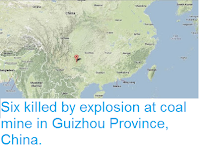Two people have been confirmed dead and twenty five are still missing following a landslide that hit the township of Zhangjiawan in Nayong Couty, Guizhou, on Monday 28 August 2017. The event happened at about 10.40 am local time, destroying 34 homes and damaging about 140 more, after several days of heavy rain in the area associated with Typhoo Hato, which made landfall in Guangdong Province on 23 August, and subsequently slowed and weakened but remained over South China. Landslides are a common problem after severe weather events, as excess
pore water pressure can overcome cohesion in soil and sediments,
allowing them to flow like liquids. Approximately 90% of all landslides
are caused by heavy rainfall. Rescue efforts in Zhangjiawan have been hampered by continuing slope instability, with emergency responders having to repeatedly retreat in the face of further landslides.
Rescue workers at the site of the Zhangjiawan landslide on 28 August 2017. Chinatopix/AP.
Tropical
storms (called Typhoons in the West Pacific and Indian Oceans) are caused by solar energy heating the air above the oceans,
which causes the air to rise leading to an inrush of air. If this
happens over a large enough area the in rushing air will start to
circulate, as the rotation of the Earth causes the winds closer to the
equator to move eastwards compared to those further away (the Coriolis
Effect). This leads to tropical storms rotating clockwise in the
southern hemisphere and anticlockwise in the northern hemisphere.These
storms tend to grow in strength as they move across the ocean and lose
it as they pass over land (this is not completely true: many tropical
storms peter out without reaching land due to wider atmospheric
patterns), since the land tends to absorb solar energy while the sea
reflects it.
See also...
Follow Sciency Thoughts on Facebook.







